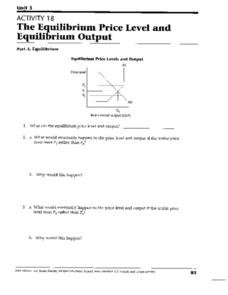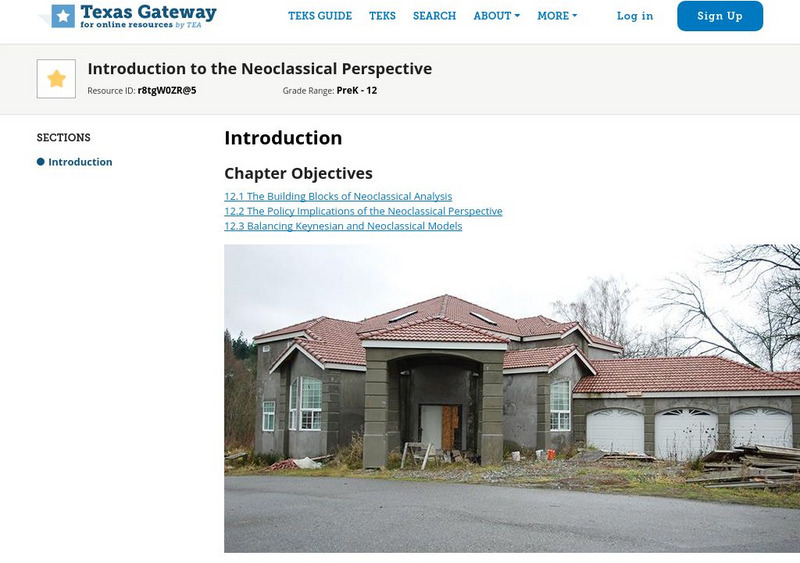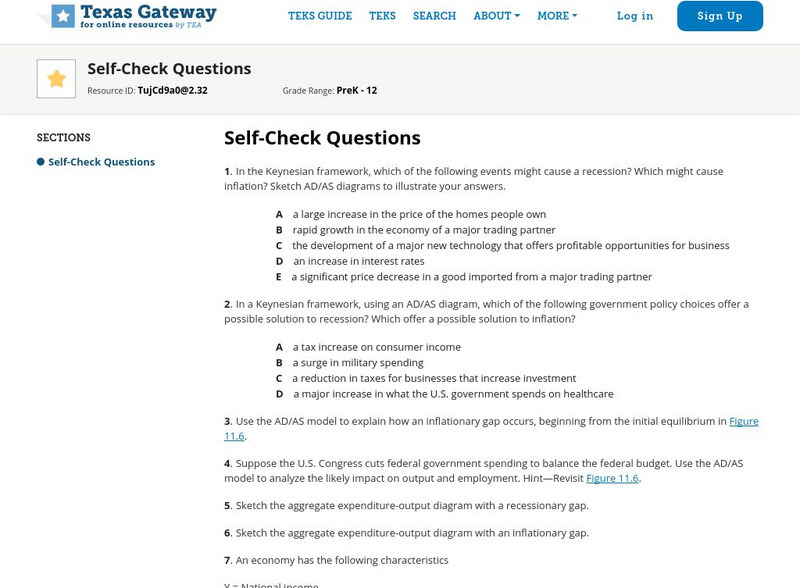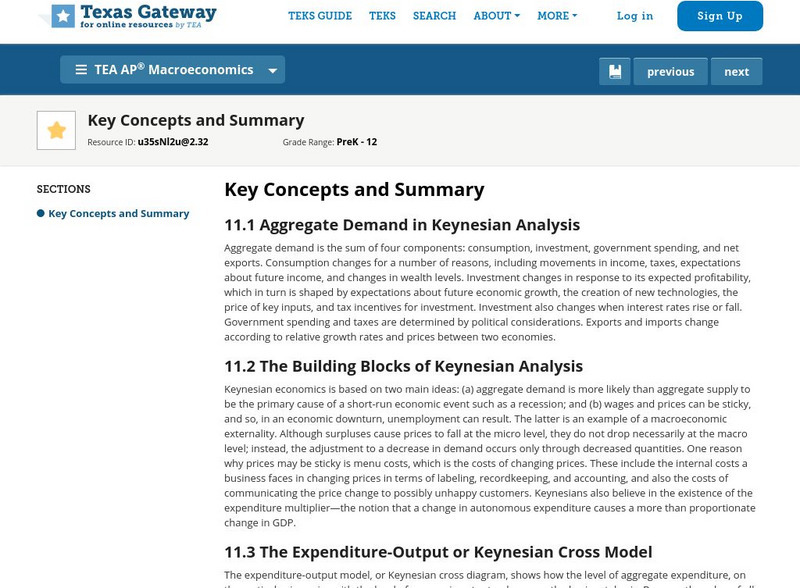Curated OER
Analyzing the Macroeconomy
Have your class take a look at the macroeconomy. Learners answer several questions using sound economic reasoning to support their responses. Students then graph information.
Curated OER
Chapter 11: Aggregate Demand and Aggregate Supply
Bring the intricacies of the Aggregate Demand-Aggregate Supply Model (AD-AS) to life in this detailed - yet understandable - presentation. Viewers will appreciate the clear explanations and graphs as they begin their adventure through...
Curated OER
Economic Health Indicators: Inflation and Unemployment Worksheet
Ensure your economists understand demand and supply curves with this 13-question inflation and unemployment worksheet. Although it references a text, information students need is included on a separate notes handout (included). Consider...
Curated OER
Discretionary and Automatic Fiscal Policy
Explore fiscal policies using this worksheet. Learners discuss economic policies as it relates to employment, aggregate demand, income tax rates, and recession.
Curated OER
The Magic of the Multiplier
In this Magic of the Multiplier worksheet, students are given an economic scenario in which they answer questions, solve problems, make predictions.
Curated OER
An Introduction to Aggregate Demand
In this economics worksheet, students respond to 3 short answer questions regarding an aggregate demand graph. In addition, students answer 8 fill in the blank questions pertaining to shifts in aggregate demand.
Curated OER
The Tools of Fiscal Policy
In this Tools of Fiscal Policy worksheet, students determine if various government policies are expansionary or contractionary, then complete a table on the effects of fiscal policy.
Curated OER
Monetarist Monetary Policy
In this Monetarist Monetary Policy worksheet, students read an article, then examine and solve a monetarist problem with variables.
Curated OER
Graphing Keynesian Monetary Policy
In this economics worksheet, students begin by reading some background information, then look at graphs which are thoroughly explained. Students then need to label, and eventually plot their own graphs based on information given.
Curated OER
The Equilibrium Price Level And the Equilibrium Output
For this economics worksheet, students answer 3 short answer questions based on an equilibrium graph. They then answer 8 questions based on 8 different situations and illustrate the equilibrium changes on the graphs. In addition,...
Curated OER
Ask Not What Your Government Can Do For You...Why Not?
Students explore tax incentives that are available for businesses to locate or expand their operations. They discuss reasons entrepreneurs should be aware of the governmental incentives that are available.
Social Science Education Consortium
Ssec: Fiscal Policy: Can Congress Diagnose and Treat an Ailing Economy? [Pdf]
This investigation examines the use of fiscal policy by the President and Congress in regulating the performance of the national economy. It begins with a brief reading that discusses the nature, objectives, and the tools of fiscal...
University of Colorado
University of Colorado: Principles of Macroeconomics: Business Cycles, Aggregate Demand and Supply
A comprehensive look at the way aggregate demand and supply affect the business cycle. Information used is current to 2003. From the Department of Economics at the University of Colorado.
Texas Education Agency
Texas Gateway: Chapter 12: The Building Blocks of Neoclassical Analysis
By the end of this section, you will be able to do the following: Explain the importance of potential GDP in the long run, analyze the role of flexible prices, interpret a neoclassical model of aggregate demand and aggregate supply, and...
Texas Education Agency
Texas Gateway: Chapter 12: Introduction to the Neoclassical Perspective
In this chapter, you will learn about the following: The building blocks of neoclassical analysis, The policy implications of the neoclassical perspective, and Balancing Keynesian and Neoclassical models.
Texas Education Agency
Texas Gateway: Chapt. 11: The Keynesian Perspective: Critical Thinking Questions
This section provides 16 study questions that require critical thinking skills. They cover the content presented in Chapter 11: The Keynesian Perspective from the Texas Gateway AP Macroeconomics online text.
Texas Education Agency
Texas Gateway: Chapter 11: The Keynesian Perspective: Review Questions
This section provides 23 review study questions to aid understanding of the content in Chapter 11: The Keynesian Perspective from the Texas Gateway AP Macroeconomics online text.
Texas Education Agency
Texas Gateway: Chapter 11: The Keynesian Perspective: Self Check Questions
This section provides a list of 12 self-check study questions covering the content of Chapter 11: The Keynesian Perspective from the Texas Gateway AP Macroeconomics online text.
Texas Education Agency
Texas Gateway: Chapter 12: Neoclassical Perspective: Problems
This section provides 5 problems to solve pertaining to the information presented in Chapter 12: Neoclassical Perspective.
Texas Education Agency
Texas Gateway: Chapter 11: The Keynesian Perspective: Key Concepts and Summary
This section summarizes the key concepts presented in Chapter 11: The Keynesian Perspective from Texas Gateway AP Macroeconomics online text.
Texas Education Agency
Texas Gateway: Chapter 11: The Phillips Curve
By the end of this section, you will be able to do the following: Explain the Phillips curve, noting its impact on the theories of Keynesian economics; graph a Phillips curve; Identify factors that cause the instability of the Phillips...
Texas Education Agency
Texas Gateway: Chapter 11: The Expenditure Output or Keynesian Cross Model
By the end of this section, you will be able to: Explain what the expenditure-output model/Keynesian cross diagram shows and what the equilibrium point on the diagram represents. Analyze the consumption function, investment function,...
Texas Education Agency
Texas Gateway: Chapter 11: Aggregate Demand in Keynesian Analysis
By the end of this section, you will be able to do the following: Evaluate the Keynesian view of recessions through an understanding of sticky wages and prices and the importance of aggregate demand; explain the coordination argument,...
Texas Education Agency
Texas Gateway: Chapter 11: Aggregate Demand in Keynesian Analysis
By the end of this section, you will be able to do the following: Explain real GDP or real output, recessionary gaps, and inflationary gaps, recognize the Keynesian aggregate demand/aggregate supply model, identify the determining...













![Ssec: Fiscal Policy: Can Congress Diagnose and Treat an Ailing Economy? [Pdf] Lesson Plan Ssec: Fiscal Policy: Can Congress Diagnose and Treat an Ailing Economy? [Pdf] Lesson Plan](https://d15y2dacu3jp90.cloudfront.net/images/attachment_defaults/resource/large/FPO-knovation.png)










